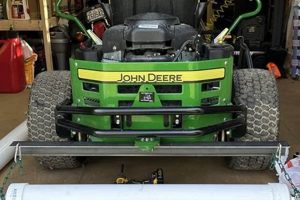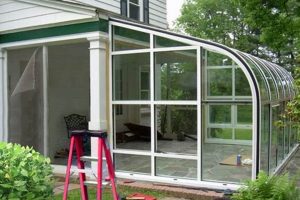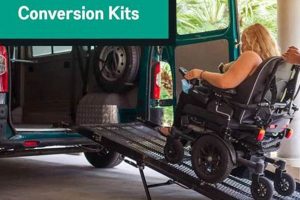An unassembled collection of components designed to facilitate the construction of a specific style of electric guitar by the end user. These sets typically include a pre-shaped body and neck, along with necessary hardware like pickups, tuning pegs, a bridge, and electronic components. The objective is to provide an accessible and cost-effective entry point into guitar building, allowing individuals to personalize an instrument to their own specifications.
The appeal stems from several factors, including the opportunity for customization, cost savings compared to purchasing a pre-built instrument, and the educational experience gained through the assembly process. Building one’s own guitar provides insight into the instrument’s construction and functionality. Kits of this nature draw on a long tradition of hobbyist crafting and musical instrument modification, providing a tangible connection to both music and woodworking.
The subsequent discussion will examine the considerations involved in selecting an appropriate set, detail the necessary tools and skills for successful assembly, and outline potential customization options to enhance the final product.
Essential Considerations for Flying V Guitar Kit Assembly
The successful completion of a guitar assembly project necessitates careful planning and execution. The following guidance addresses critical aspects to ensure a satisfactory outcome.
Tip 1: Component Inventory and Verification: Upon receipt, meticulously inventory all kit components against the provided parts list. Discrepancies should be reported to the supplier immediately to avoid project delays.
Tip 2: Neck Alignment and Fit Assessment: Prior to any permanent attachment, test-fit the neck to the body pocket. Ensure proper alignment, angle, and a snug, gap-free fit. Adjustments may be required to the neck pocket or heel.
Tip 3: Electronic Component Grounding Scheme: Adhere strictly to the wiring diagram and ensure a proper grounding scheme. This is crucial for minimizing noise and ensuring optimal electronic performance. Verify continuity with a multimeter.
Tip 4: Finish Application Preparation: Thoroughly sand the body and neck surfaces with progressively finer grits of sandpaper prior to applying any finish. This creates a smooth and even surface for optimal finish adhesion and appearance.
Tip 5: Hardware Placement and Pilot Holes: Carefully plan the placement of all hardware components (bridge, tuners, strap buttons) and drill pilot holes before installing screws. This prevents wood splitting and ensures accurate positioning.
Tip 6: String Alignment and Intonation: After assembly, string the guitar and verify string alignment over the neck. Adjust the bridge saddle positions to achieve proper intonation across the fretboard.
Tip 7: Fret Leveling and Dressing: Evaluate fret height and level. Uneven frets can cause buzzing and intonation issues. Employ fret leveling tools and dressing techniques as needed for optimal playability.
Adherence to these considerations will significantly increase the likelihood of a successful build, resulting in a playable and aesthetically pleasing instrument.
The following sections will explore specific customization possibilities and advanced finishing techniques.
1. Wood Quality
The selection of wood is paramount in the construction of any stringed instrument, including a DIY flying V guitar kit. The species chosen directly influences the guitar’s tonal characteristics, weight, and aesthetic appeal. Softer woods, such as basswood, are often favored for their affordability and ease of machining, but they may lack the tonal complexity and sustain of denser alternatives. Hardwoods like mahogany or ash provide enhanced sustain and a richer tonal palette, but can present challenges during the assembly process due to their increased density and potential for splintering.
The specific cuts of wood used are also significant. A body crafted from multiple pieces of wood glued together may exhibit inconsistent grain patterns or tonal properties compared to a single, solid piece. Similarly, the orientation of the wood grain in the neck impacts its stability and resistance to warping under string tension. A properly quarter-sawn neck, for instance, is less susceptible to bending than a flat-sawn neck. The quality and stability of the wood components are central to ensuring the finished instrument not only looks appealing but also functions reliably and produces the desired sound.
Therefore, when considering a DIY flying V guitar kit, it is crucial to investigate the wood species and construction methods employed. While cost is a factor, compromising on wood quality can lead to a final product that is sonically inferior and potentially prone to structural issues. A thorough understanding of wood characteristics and their impact on the instrument’s performance will significantly contribute to a successful build and a satisfying playing experience.
2. Hardware Compatibility
Hardware compatibility represents a critical determinant of success for any DIY flying V guitar kit project. Incompatibility between the included components, or between kit components and intended aftermarket upgrades, can lead to significant functional problems and ultimately compromise the instrument’s playability. Consider, for instance, a situation where the bridge posts provided with the kit do not properly fit the pre-drilled holes in the guitar body. This necessitates either modification of the body, potentially weakening its structure, or the acquisition of replacement bridge hardware, incurring additional expense and delaying the build. Similarly, incompatibility between the tuning machines and the headstock holes can lead to tuning instability and compromised string alignment. Correct hardware selections are essential for ensuring seamless integration and optimal performance.
The importance of verifying hardware specifications prior to and during assembly cannot be overstated. For example, the dimensions of potentiometers must align with the pre-drilled control cavity holes. If they do not, enlarging the holes may cause cosmetic damage or affect the guitar’s shielding. Furthermore, the thread pitch and length of mounting screws must be appropriate for the wood density to prevent stripping or insufficient anchoring. Instances where the provided nut is not properly slotted for the intended string gauge will result in buzzing or intonation issues. Understanding these potential pitfalls and proactively addressing hardware compatibility issues is vital for a successful assembly.
In conclusion, hardware compatibility in a DIY flying V guitar kit context transcends mere convenience; it dictates the instrument’s functionality, playability, and long-term reliability. A thorough assessment of hardware specifications, a meticulous approach to parts inventory a
nd verification, and a willingness to address potential compatibility challenges are essential prerequisites for realizing a playable and satisfying instrument. Ignoring this crucial aspect invites frustration and undermines the intended benefits of assembling a personalized guitar.
3. Electronic Configuration
Electronic configuration is a pivotal aspect within the context of a DIY flying V guitar kit. It determines the instrument’s tonal characteristics, versatility, and overall functionality. The selection and integration of electronic components dictate the sound output and define the guitar’s sonic capabilities.
- Pickup Selection and Placement
The choice of pickups is fundamental to the guitar’s sound. Humbuckers, single-coils, and P90s each offer distinct tonal profiles suited to different musical genres. Humbuckers typically provide a thicker, higher-output sound, while single-coils deliver a brighter, more articulate tone. Pickup placement also significantly influences the sound; positioning a pickup closer to the bridge results in a brighter, more aggressive tone, while positioning it closer to the neck produces a warmer, rounder sound. In a DIY kit, understanding the sonic characteristics of different pickups and their optimal placement is crucial for achieving the desired sound. Example: A kit intended for heavy metal may include high-output humbuckers, while a kit designed for blues may feature vintage-style single-coils.
- Potentiometer and Capacitor Values
Potentiometers control the volume and tone of the guitar, and their values significantly impact the electronic circuit’s behavior. Higher-value potentiometers (e.g., 500k ohms) allow more high frequencies to pass through, resulting in a brighter sound, while lower-value potentiometers (e.g., 250k ohms) attenuate high frequencies, creating a warmer tone. Capacitors in the tone circuit shape the frequencies that are cut when the tone knob is adjusted. Different capacitor values result in different tonal characteristics; for example, a larger capacitor will attenuate more bass frequencies, while a smaller capacitor will attenuate more treble frequencies. Matching potentiometer and capacitor values to the chosen pickups is essential for achieving the desired tonal response. Example: Humbuckers often pair well with 500k potentiometers and .022uF capacitors, while single-coils may benefit from 250k potentiometers and .047uF capacitors.
- Wiring Scheme and Switch Configuration
The wiring scheme and switch configuration determine how the pickups are connected to the output jack and how they can be selected or combined. Common wiring schemes include series, parallel, and coil-splitting configurations. Series wiring provides a higher output and a thicker tone, while parallel wiring offers a lower output and a brighter tone. Coil-splitting allows humbucker pickups to be used as single-coils, providing a wider range of tonal options. The switch configuration determines how the pickups are selected; a three-way switch is typical, but more complex switches can provide additional pickup combinations. In a DIY kit, understanding the different wiring schemes and switch configurations allows for customization of the guitar’s sonic capabilities. Example: A three-way switch can be wired to select the neck pickup, the bridge pickup, or both pickups in parallel, while a five-way switch can offer additional combinations, such as coil-splitting options.
- Shielding and Grounding
Shielding and grounding are crucial for minimizing noise and interference in the guitar’s electronic circuit. Shielding involves covering the control cavity and pickup cavities with a conductive material, such as copper foil or conductive paint, to prevent electromagnetic interference from entering the circuit. Grounding involves connecting all of the metal parts of the guitar, such as the bridge, tuners, and potentiometers, to a common ground point to prevent ground loops and reduce hum. Proper shielding and grounding are essential for achieving a clean and noise-free sound. Example: A poorly shielded guitar may exhibit excessive hum or buzz, particularly when used near electronic devices.
In summary, the electronic configuration of a DIY flying V guitar kit is a critical determinant of the instrument’s sonic capabilities. Careful selection and integration of pickups, potentiometers, capacitors, wiring schemes, and shielding techniques are essential for achieving the desired sound and ensuring optimal performance. The versatility and utility of the instrument are all decided here. The degree to which these aspects are well thought out and executed directly contributes to the value and enjoyment derived from the finished guitar.
4. Neck Joint Precision
Neck joint precision represents a critical factor in the overall quality and performance of any stringed instrument, especially within the context of a do-it-yourself electric guitar kit. The accuracy and stability of the neck-to-body connection profoundly influence intonation, sustain, and playability. A poorly executed neck joint can render the instrument unplayable, regardless of the quality of other components. Therefore, understanding and meticulously addressing neck joint precision is paramount for success.
- Fit and Alignment
A snug and properly aligned neck-to-body joint ensures optimal transfer of vibrational energy. Gaps or misalignments can dampen resonance, resulting in diminished sustain and a lifeless tone. The neck angle must be precisely calibrated to achieve the correct string height and allow for proper bridge adjustment. In the context of a kit, verifying the neck pocket dimensions and neck heel shape prior to assembly is essential. Any discrepancies should be addressed before proceeding, potentially requiring careful sanding or shimming to achieve a precise fit.
- Joint Stability
The neck joint must withstand significant string tension without shifting or flexing. A weak or unstable joint can lead to intonation problems, buzzing, and even structural failure over time. Bolt-on necks rely on the precise fit of the neck heel within the body pocket, as well as the strength and number of the mounting screws. Set-neck joints, where the neck is glued to the body, require a tight bond and adequate surface area for optimal stability. Proper clamping during glue-up is crucial for set-neck construction. In a DIY scenario, choosing high-quality hardware and adhesives is essential for ensuring long-term joint stability.
- Intonation Accuracy
The neck joint’s accuracy directly impacts the instrument’s intonation the ability to play in tune across the entire fretboard. A misaligned neck can cause notes to be sharp or flat, particularly in the upper registers. Proper alignment ensures that the scale length is consistent and that the strings vibrate in the correct relationship to the frets. When assembling a kit, meticulous attention to neck alignment and scale length measurement is crucial for achieving accurate intonation.
- Playability and Comfort
The neck joint influences the overall playing experience. A well-executed joint allows for comfortable access to the higher frets and facilitates smooth transitions along the fretboard. A bulky or poorly shaped joint can hinder access and make playing difficult. In a DIY
project, careful shaping of the neck heel and body contouring around the joint can improve playability and comfort. Considerations such as heel shape, body contours, and access cuts influence player comfort.
In conclusion, neck joint precision is not merely a cosmetic detail but a fundamental determinant of a guitar’s playability, tone, and structural integrity, especially for those engaging with an unassembled electric guitar. Careful attention to fit, stability, intonation, and playability is essential. A properly executed neck joint translates into an instrument that is both enjoyable to play and capable of producing consistent, accurate musical tones.
5. Finishing Techniques
The application of appropriate finishing techniques is a crucial step in the construction of a DIY flying V guitar kit, significantly impacting the instrument’s aesthetic appeal, durability, and, to a lesser extent, its tonal properties. The finish serves as a protective barrier against moisture, scratches, and other environmental factors, while also enhancing the visual presentation of the wood grain and overall design.
- Surface Preparation
Proper surface preparation is paramount before any finish is applied. This involves sanding the wood smooth with progressively finer grits of sandpaper to remove imperfections and create an even surface for the finish to adhere to. Any remaining dust or residue must be thoroughly removed to prevent contamination of the finish. Example: Failure to properly sand the wood may result in an uneven finish with visible scratches or imperfections. In the context of a DIY kit, diligent surface preparation sets the foundation for a professional-looking outcome.
- Sealing
Sealing the wood is often a necessary step to prevent the finish from being absorbed unevenly into the wood pores. A sanding sealer or wood conditioner is typically applied to fill the pores and create a uniform surface for the topcoat. This ensures that the finish has a consistent sheen and prevents “sinking” into the wood over time. Example: Applying a sealer to a mahogany body before applying a clear coat will help to prevent the mahogany from absorbing the clear coat unevenly, resulting in a smoother, more consistent finish. This step is crucial in DIY kits where different wood types might be used.
- Application Methods
Various application methods can be employed, including spraying, brushing, and wiping. Spraying provides the most even and professional-looking results but requires specialized equipment and a well-ventilated area. Brushing and wiping are more accessible to DIY enthusiasts but require careful technique to avoid brush strokes or uneven coverage. Example: Spraying lacquer typically requires multiple thin coats to build up the desired thickness, while brushing polyurethane requires careful attention to avoid brush marks. When working on a DIY flying V guitar kit, selecting an application method that aligns with skill level and available resources is critical.
- Types of Finishes
Several types of finishes are commonly used on guitars, including lacquer, polyurethane, and oil-based finishes. Lacquer provides a thin, glossy finish that allows the wood to breathe, but it is less durable than polyurethane. Polyurethane offers excellent protection against scratches and moisture but can be more difficult to apply evenly. Oil-based finishes provide a natural look and feel but require regular maintenance. Example: Nitrocellulose lacquer is often preferred for vintage-style guitars due to its tonal properties and aesthetic qualities, while polyurethane is commonly used for modern guitars due to its durability. DIY kit builders often choose based on desired aesthetics and durability requirements.
In summary, the selection and application of appropriate finishing techniques are integral to the successful completion of a DIY flying V guitar kit. Proper surface preparation, sealing, application methods, and finish types all contribute to the instrument’s final appearance, durability, and overall value. Mastering these techniques is essential for achieving a professional-quality result and ensuring the longevity of the instrument.
6. Assembly Documentation
In the realm of “diy flying v guitar kit” construction, assembly documentation serves as the cornerstone for successful project completion. It provides a structured roadmap, mitigating potential errors and facilitating the realization of a functional instrument.
- Comprehensive Parts List
A detailed inventory of all included components is essential. This list should specify the quantity, dimensions, and materials of each part, enabling verification upon receipt and minimizing the risk of missing or incorrect items. Discrepancies at this stage can significantly impede the assembly process. Examples may include specific screw lengths, potentiometer values, or pickup types, all crucial for their intended function within the “diy flying v guitar kit.”
- Schematic Diagrams and Wiring Instructions
For the electronic components, clear and accurate schematic diagrams and wiring instructions are indispensable. These diagrams should illustrate the proper connections between pickups, potentiometers, switches, and the output jack. Incorrect wiring can result in non-functional electronics, noise issues, or even damage to components. High-quality documentation will present these connections in a readily understandable format, even for individuals with limited electronics experience in the “diy flying v guitar kit” realm.
- Step-by-Step Assembly Guide
A sequential guide outlining the assembly process is critical. This guide should provide clear instructions, accompanied by visual aids such as photographs or illustrations, for each stage of the build. From attaching the neck to installing the hardware and wiring the electronics, each step should be clearly delineated to minimize ambiguity and potential errors. Torque specifications for screws and critical alignment procedures should also be included in “diy flying v guitar kit” context.
- Troubleshooting Information
Anticipating potential problems and providing troubleshooting information is beneficial. This section should address common issues encountered during assembly, such as string buzzing, electronic noise, or intonation problems. Offering diagnostic steps and potential solutions can empower the builder to resolve issues independently, reducing frustration and expediting project completion of their “diy flying v guitar kit.”
The presence of thorough and accessible assembly documentation transforms a collection of parts into a manageable project. It not only guides the builder through the process but also imparts valuable knowledge about the instrument’s construction and function. Proper documentation can effectively mitigate risks associated with “diy flying v guitar kit” assembly, ultimately resulting in a playable and satisfying instrument.
7. Playability Adjustments
Playability adjustments represent the culminating an
d arguably most crucial stage in the creation of a functional musical instrument from a “diy flying v guitar kit.” The preceding steps, involving component assembly and finishing, establish the foundation, but the final adjustments determine the instrument’s tactile responsiveness and the ease with which it can be played. Poorly executed adjustments can negate the efforts invested in earlier stages, resulting in an instrument that is aesthetically pleasing but fundamentally unsatisfying to play. Examples of such adjustments include setting the string action (height of the strings above the frets), adjusting the intonation (ensuring accurate pitch across the fretboard), and optimizing the neck relief (the slight curvature of the neck). Each adjustment directly impacts the player’s ability to produce accurate notes with minimal effort. If the action is too high, the player must exert excessive force to fret the strings, leading to fatigue and difficulty executing complex passages. If the intonation is inaccurate, notes will be out of tune, rendering the instrument unusable in ensemble settings. Neck relief that is either insufficient or excessive can cause buzzing or intonation issues.
The process of making playability adjustments typically involves a combination of objective measurements and subjective evaluation. String height is measured using a precision ruler at specific points on the fretboard. Intonation is assessed using an electronic tuner, comparing the pitch of open strings to the pitch at the 12th fret. Neck relief is measured using a straightedge and feeler gauges. However, these measurements provide only a starting point. The final adjustments are often made based on the player’s individual preferences and playing style. For example, a player with a lighter touch may prefer a lower action, while a player who uses heavier strings may require more neck relief. Skilled luthiers possess the knowledge and experience to translate these preferences into precise adjustments that optimize the instrument’s playability. Within the context of a “diy flying v guitar kit,” the builder assumes this role, necessitating a thorough understanding of the principles involved and the techniques required to execute them effectively. Tools like nut files, fret rockers, and specialized wrenches become invaluable. The correct use of these tools combined with an understanding of the principles of guitar setup will greatly affect the comfort and playability of the finished guitar.
Achieving optimal playability is often an iterative process, requiring multiple adjustments and evaluations. It is not uncommon to spend several hours fine-tuning these parameters to achieve the desired result. The challenges associated with playability adjustments underscore the importance of patience, precision, and a willingness to experiment. Moreover, they highlight the interconnectedness of the various aspects of guitar construction. The neck joint, fretwork, and hardware all influence the instrument’s playability, and adjustments to one area may necessitate adjustments to others. The understanding that playability adjustments are not an isolated step, but an integral part of the overall construction process, is essential for a successful “diy flying v guitar kit” outcome. In summary, meticulous playability adjustments are not merely the final touches, but are instead, the transformation of a collection of parts into a cohesive, responsive, and enjoyable musical instrument.
Frequently Asked Questions
The following addresses common inquiries regarding the assembly and use of an electric guitar construction set. These aim to provide clarity and guidance for prospective builders.
Question 1: What level of woodworking experience is required to successfully assemble a Flying V guitar kit?
While extensive experience is not mandatory, a basic understanding of woodworking principles is advantageous. Familiarity with hand tools (e.g., screwdrivers, sandpaper, files) and power tools (e.g., drills, soldering irons) is recommended. Novices should anticipate a steeper learning curve and allocate additional time for the project.
Question 2: What are the essential tools required for kit assembly, beyond those typically found in a basic toolkit?
Beyond standard hand tools, specific instruments are recommended. These include a precision straight edge, fret rocker, nut files, a soldering iron with solder, a multimeter, and a set of specialized guitar setup tools (e.g., string action gauge, radius gauges).
Question 3: How long does it typically take to complete a Flying V guitar kit project?
The assembly duration varies based on skill level, complexity of the kit, and desired level of customization. A conservative estimate for a first-time builder ranges from 40 to 60 hours. Experienced individuals may complete the project in significantly less time.
Question 4: What are the most common pitfalls encountered during kit assembly, and how can they be avoided?
Frequent issues include incorrect wiring, improper neck alignment, and inadequate finishing. Careful adherence to the provided instructions, meticulous planning, and thorough component verification are crucial for mitigation. Seeking guidance from online forums or experienced builders can also prove beneficial.
Question 5: Can the components included in the kit be upgraded or replaced with aftermarket parts?
Yes, most components can be upgraded. However, compatibility must be carefully considered. Verify that replacement parts are dimensionally compatible with the existing hardware and that any electronic upgrades are appropriate for the existing wiring scheme.
Question 6: What steps should be taken to ensure proper intonation and setup after completing the assembly?
Following assembly, string the guitar and utilize an electronic tuner to adjust the bridge saddles for correct intonation at the 12th fret. Adjust the string action to the desired height and optimize the neck relief by adjusting the truss rod. Numerous online resources provide detailed guidance on guitar setup procedures.
Careful planning, meticulous execution, and a willingness to learn from potential challenges are key to successfully assembling a “diy flying v guitar kit.” The result, a personalized instrument, is worth the time and effort.
The subsequent sections will explore case studies and testimonials from individuals who have successfully completed “diy flying v guitar kit” projects, offering further insights and inspiration.
Conclusion
The preceding exploration of “diy flying v guitar kit” has addressed the multifaceted aspects involved in assembling a personalized electric guitar. Discussions encompassed component selection, essential tools, woodworking techniques, electronic configuration, finishing processes, and playability adjustments. Each stage presents unique challenges and opportunities for customization, directly impacting the final instrument’s functionality and aesthetic appeal.
Potential builders are encouraged to approach the project with meticulous planning, a commitment to continuous learning, and a realistic assessment of their skills. While the assembly process demands patience and precision, the potential reward lies in owning a customized instrument and gaining invaluable insights into the craft of guitar construction.







